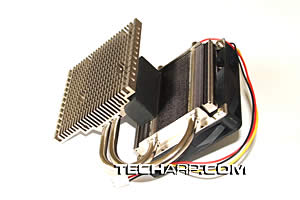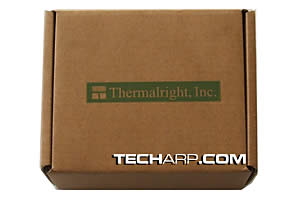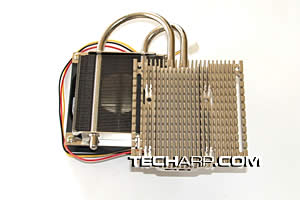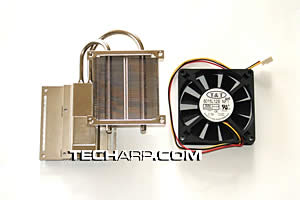Thermalright V1
The V1 is Thermalright's first venture into the graphics card cooling market, having only made CPU heatsinks for a number of years. Whilst the V1 has been somewhat superceded by a newer version with 3 heatpipes, the V1 Ultra, that does not mean the V1 is any slouch of a cooler.
Now, V1 is actually not compatible with the Radeon X1800, but
we'll make it work. That shouldn't be as hard as mounting the Sytrin VF1, right? ![]()
The V1 package includes the heatsink, a low-profile 80x15mm fan (it's a rare sight to see a fan inside a Thermalright box!), eight aluminium RAM heatsinks, a whole heap of mounting hardware, a manual, a big tube of thermal paste, and a case sticker.
The Thermalright V1 is a little bit of an odd design, but one must bear in mind that the idea was to keep it thin enough to serve as a single-slot cooling solution. However, the fin section can cause problems if you have a big CPU cooler and the CPU socket is too close to your graphics card.
This was exactly what happened in my case. I had the Thermalright SI-120 mounted on a DFI nF4 Ultra-D. As a result, I was unable to use the 80mm fan on top of the heatsink, as it meant to.
 |
Here's what the V1 looks like, out of the box. This is why we love Thermalright - they pay attention to the little details.
There is a thick black piece of foam wedged between the two sections of the heatsink. This protects it during storage and transportation.
The Thermalright V1 installation is a little complex, involving quite a number of parts. However, the instructions are quite clear and everything worked as expected.
Overall, the Zalman VF900 definitely gets top marks for ease of installation, and between the Thermalright V1 and the Sytrin VF1, the Thermalright heatsink is clearly the lesser of two evils.
Stock Cooler
The Radeon X1800 GTO's stock cooler was also tested to see how well (or how badly) it fared against some of the best aftermarket solutions.
It is a reference-design cooler identical to those used on the ATI Radeon X1800XL. It has a large copper core surrounded by a block of aluminium which draws heat away from the memory chips. A thick grey thermal pad was used for thermal transfer, not unlike those found on AMD stock coolers.
A 45mm ADDA blower draws air in and pushes it out the other end of the heatsink, through the copper fins which radiates heat from the copper base.
Now that you've been introduced to all the contenders, let's move on to the results!
<<< Sytrin VF1 (Continued) - Design & Build Quality : Previous Page | Next Page : Testing The Coolers - Test Bed, Methodology >>>







 Add to Reddit
Add to Reddit




